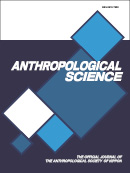113 巻, 3 号
選択された号の論文の9件中1~9を表示しています
- |<
- <
- 1
- >
- >|
Original Articles
-
2005 年 113 巻 3 号 p. 237-244
発行日: 2005年
公開日: 2005/12/21
[早期公開] 公開日: 2005/06/29PDF形式でダウンロード (234K) HTML形式で全画面表示 -
2005 年 113 巻 3 号 p. 245-252
発行日: 2005年
公開日: 2005/12/21
[早期公開] 公開日: 2005/04/22PDF形式でダウンロード (329K) HTML形式で全画面表示 -
2005 年 113 巻 3 号 p. 253-258
発行日: 2005年
公開日: 2005/12/21
[早期公開] 公開日: 2005/04/22PDF形式でダウンロード (1317K) HTML形式で全画面表示 -
2005 年 113 巻 3 号 p. 259-271
発行日: 2005年
公開日: 2005/12/21
[早期公開] 公開日: 2005/04/22PDF形式でダウンロード (573K) HTML形式で全画面表示 -
2005 年 113 巻 3 号 p. 273-289
発行日: 2005年
公開日: 2005/12/21
[早期公開] 公開日: 2005/04/22PDF形式でダウンロード (545K) HTML形式で全画面表示
Brief Communication
-
2005 年 113 巻 3 号 p. 291-293
発行日: 2005年
公開日: 2005/12/21
[早期公開] 公開日: 2005/04/22PDF形式でダウンロード (111K) HTML形式で全画面表示
Material Report
-
2005 年 113 巻 3 号 p. 295-300
発行日: 2005年
公開日: 2005/12/21
[早期公開] 公開日: 2005/04/22PDF形式でダウンロード (121K) HTML形式で全画面表示
Book Reviews
-
2005 年 113 巻 3 号 p. 301_1
発行日: 2005年
公開日: 2005/12/21
PDF形式でダウンロード (69K) -
2005 年 113 巻 3 号 p. 301_2-303
発行日: 2005年
公開日: 2005/12/21
PDF形式でダウンロード (89K)
- |<
- <
- 1
- >
- >|
